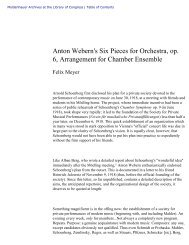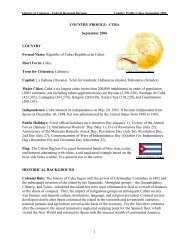1 - American Memory
1 - American Memory
1 - American Memory
Create successful ePaper yourself
Turn your PDF publications into a flip-book with our unique Google optimized e-Paper software.
3M<br />
The latter three unions are certified as a single bargaining unit under the<br />
name of "Pacific District—Seafarers' International Union," but each component<br />
union maintains its autonomy and negotiates separately for "departmental<br />
working rules" and wage application.<br />
To indicate the extent of the cargo handling operations covered by the PMU-<br />
ILWU agreement, the PMA 1973 annual payroll for longshoremen and maritime<br />
clerics was $146,884,949 for wages and vacations, and $41,921,550 for fringe<br />
benefits. 11,745 registered men were regularly employed, and 70,524,772 tons of<br />
dry cargo were loaded or discharged. Liquid cargo, such as petroleum. Is not<br />
included in these figures.<br />
Pacific Coast based <strong>American</strong> Flag vessels covered by the agreements with<br />
seafaring unions averaged 61 during the year 1973. The annual payroll for all<br />
seafarers amounted to $64,641,588 in wages and vacations, and $35,777,291 in<br />
fringe benefit payments. The average number of seamen employed was 3,437.<br />
These totals do not Include costs, vessels or employment of seamen for <strong>American</strong><br />
Flag vessels under Atlantic or Gulf Coast union agreements, nor similar figures<br />
for foreign flag vessels calling at Pacific Coast ports.<br />
Dry cargo operations on the Pacific Coast amount to between 20 and 25 per-<br />
cent of the national total.<br />
Against this brief background description of Pacific Coast employer-union re-<br />
lationships and the scope of maritime operations, we intend to discuss the pro-<br />
posals contained in H.R. 7189, which affords strike protection for Hawaii and<br />
other U.S. Pacific Islands.<br />
At the outset of this discussion. Pacific Maritime Association would like the<br />
record to show that it is very much aware of the hardships visited upon Hawaii<br />
and other U.S. Pacific Islands when a West Coast dock or shipping strike cuts<br />
off supplies and sources of income needed for the day to day life of those islands.<br />
The intent of H.R. 7189 Is, of course, to relieve those hardships.<br />
Nevertheless, we cannot support H.R. 7189 for the following three principal<br />
reasons:<br />
1. It would weaken the economic bargaining power of the employers,<br />
2. It would create divisiveness among the employers in the multi-employer<br />
bargaining group, and<br />
3. It would dilute the weight of public interest pressure that might either<br />
prevent a work stoppage or force an early termination of a work stoppage.<br />
1. ECONOMIC BABOAimNO POWEB OF THE EMPL0TEB8<br />
H.R. 7189, in a West Coast dock strike, would require the handling by long-<br />
shoremen of cargo destined to or coming from Hawaii or other designated United<br />
States Pacific islands. This means that part of the striking longshore work force<br />
would be provided Income during the strike. Stripped of niceties, the proposed<br />
bill provides strike benefits to longshoremen. Strike benefits, particularly when<br />
they do not come out of the usual source—namely, the union treasury—make a<br />
union less apprehensive about calling a strike, and once a strike is called less<br />
impelled to terminate it. Thus, whatever balance of economic bargaining power<br />
is supposed to exist between employers and unions is tilted in favor of unions.<br />
Some who favor adoption of H.R. 7189 argue that the longshore hours required<br />
to handle Hawaiian cargo, for example, is not so great as to create any worrisome<br />
imbalance. We do not have a precise breakout of these hours, but conservatively<br />
we believe that it would probably be at least 5% of total hours normally worked<br />
on the West Coast. Not much? Perhaps not in isolation. But there are also hours<br />
required to handle military cargo and some continuing ever-present longshore<br />
activities. During the 1971-72 West Coast dock strike, in some weeks in the San<br />
Francisco Bay Area alone, the hours for handling military and other activities<br />
went above 30% of hours normally worked in nonstrike periods.<br />
Thus with Hawaiian and other island cargo hours thrown in, there would be<br />
substantial work opportunity for "striking workers." The industry Is thus forced<br />
to subsidize the strike against the industry. And the .situation would likely<br />
worsen. After Hawaii, how do you avoid the same consideration for Alaska?<br />
Or for a distressed California citrus industry? Or for a Northwest grain indus-<br />
try? The exceptions would proliferate.<br />
2. DIVISIVENESS AMONG THE EUPLOTEBS<br />
Paclflc Maritime Association bargains with shoreslde and some of the oflTshore<br />
anions In a multi-employer bargaining unit, as required by decisions of the



![Albert Einstein Papers [finding aid]. Library of Congress. [PDF ...](https://img.yumpu.com/21604228/1/190x245/albert-einstein-papers-finding-aid-library-of-congress-pdf-.jpg?quality=85)





![American Colony in Jerusalem Collection [finding aid]. Library of ...](https://img.yumpu.com/17941275/1/190x245/american-colony-in-jerusalem-collection-finding-aid-library-of-.jpg?quality=85)



![Piccard Family Papers [finding aid]. - American Memory - Library of ...](https://img.yumpu.com/17941234/1/190x245/piccard-family-papers-finding-aid-american-memory-library-of-.jpg?quality=85)


